In occasione delle recenti celebrazioni per l’arrivo di Costa Venezia e l’innovativa MSC Bellissima, pubblichiamo la nostra intervista a Matteo Martinuzzi, storico navale, collaboratore per Il Secolo XIX, The Medi Telegraph ed esperto di crociere. L’incontro è avvenuto in occasione della nostra visita al MuCa -Museo della Cantieristica e allo stabilimento Fincantieri di Monfalcone, in quella che si è rivelata essere una serie di interessanti visite guidate organizzate dal Comune di Monfalcone in accordo con Fincantieri e il museo stesso, che ha sede al pianterreno dell’ex Albergo operai del Villaggio di Panzano.
UD: Le ultime grandi navi danno l’impressione di ricercare nuovamente un contatto con il mare, ponti esterni più estesi, promenades… E’ solo una impressione o alle spalle c’è effettivamente una scelta commerciale ragionata?
“Diciamo che il prodotto della nave nasce dalla richiesta dell’armatore.  L’armatore, che richiede una commessa, fa una “wish list” con le caratteristiche del nave. Quindi, la tendenza a trovare aree esterne deriva da una richiesta dell’armatore, non è una questione di mercato. Deriva soprattutto da dove verrà posizionata la nave e dalle rotte che dovrà fare. La Seaside, per esempio, è una nave che è stata progettata per i climi caldi. La “wish list” che l’armatore fornisce al cantiere costruttore prevede in questo caso una nave per i climi caldi. Però, faccio un esempio: una nave come la Costa Venezia viene concepita con piscine coperte, perché segue le esigenze di una clientela che non ama stare al sole (la clientela cinese ndr.). Quindi non c’è una tendenza fissa secondo la quale le navi del futuro saranno tutte aperte. La Symphony of The Seas è una nave molto chiusa al mare, orientata all’interno, ma resta comunque una nave bellissima. Quindi diciamo che il mercato varia e gli armatori cercano in base al loro brand di offrire ai passeggeri qualcosa di diverso. Ci sono, adesso, in cantiere una serie di navi molto aperte al mare, che vengono dal progetto della Seaside ma non è detto che ci sia questa tendenza generale”.
L’armatore, che richiede una commessa, fa una “wish list” con le caratteristiche del nave. Quindi, la tendenza a trovare aree esterne deriva da una richiesta dell’armatore, non è una questione di mercato. Deriva soprattutto da dove verrà posizionata la nave e dalle rotte che dovrà fare. La Seaside, per esempio, è una nave che è stata progettata per i climi caldi. La “wish list” che l’armatore fornisce al cantiere costruttore prevede in questo caso una nave per i climi caldi. Però, faccio un esempio: una nave come la Costa Venezia viene concepita con piscine coperte, perché segue le esigenze di una clientela che non ama stare al sole (la clientela cinese ndr.). Quindi non c’è una tendenza fissa secondo la quale le navi del futuro saranno tutte aperte. La Symphony of The Seas è una nave molto chiusa al mare, orientata all’interno, ma resta comunque una nave bellissima. Quindi diciamo che il mercato varia e gli armatori cercano in base al loro brand di offrire ai passeggeri qualcosa di diverso. Ci sono, adesso, in cantiere una serie di navi molto aperte al mare, che vengono dal progetto della Seaside ma non è detto che ci sia questa tendenza generale”.
Photo by Brandon Nelson on Unsplash
UD: A proposito di aspetti più tecnici, abbiamo anche visto che ci sono delle “prue nuove” su alcune navi. Sulla AidaNova o anche sulla Virgin, con una forma più verticale, fendente. C’è una ragione alle spalle? Qualche vantaggio idrodinamico?
Una prua non viene fatta a casaccio, ci sono alle spalle degli studi di carena per migliorare l’efficienza. Diciamo che la prua di tipo verticale, con bulbi non pronunciati, nasce perché la nave è progettata per velocità di esercizio più basse. La tendenza delle navi del futuro, con questo tipo di prua, è che faranno velocità medie più basse e quindi risparmieranno più carburante. Il bulbo, come si intende sulle navi normali, è efficiente solo sopra i 16 nodi. Quindi si può pensare che queste navi navigheranno ad una velocità inferiore. E’ una linea che viene fatta per risparmiare sul carburante e ovviamente le navi faranno degli itinerari differenti rispetto ad altre con velocità superiori di esercizio.

UD: Con Peter Knego avevamo parlato delle differenze di estetica tra i liners di un tempo e le navi di oggi. Quelle di una volta erano progettate da grandi architetti (Renzo Piano e la Crown Princess del 1990), oggi invece sembra che si punti maggiormente ad altri aspetti. E’ vero?
In realtà si punta ancora all’estetica. Fincantieri è molto brava nel ridurre l’effetto “scatola” con espedienti architettonici. Il volume commerciale è un “cubo” per sfruttare al meglio gli spazi; però comunque gli architetti navali di Fincantieri cercano di ridurre questo effetto con alcuni accorgimenti, come i balconi colorati che alleggeriscono la linea della nave. Ed esempio, MSC Seaside ha un lamierino a poppa che fa una leggera curva verso gli ascensori e serve per migliorare l’estetica della nave. Si cerca di migliorare la nave mantenendo la massima efficienza da un punto di vista commerciale ed economico. Non è che non si guardi all’estetica, quando parlavamo di transatlantici era completamente differente, la nave rappresentava il Paese, era un ambasciatore, se ne facevano poche, non erano un prodotto commerciale come le navi da crociera di oggi. Una filosofia completamente nuova. Il transatlantico faceva linea e già in se stesso doveva essere più veloce, doveva avere linee più filanti per essere penetrante nell’acqua. Nella nave di adesso l‘interesse è nello sfruttare gli spazi commerciali.

UD: Il liner era un prodotto unico, un’icona dello stile, un simbolo. La nave di oggi è una serie, un numero quindi…
Per le navi italiane di un tempo venivano fatti dei concorsi, dovevano rappresentare al meglio il Made in Italy. Oggi la nave non rappresenta questo. La nave dal punto di vista architettonico non deve rappresentare un paese ma la sua funzionalità commerciale e la sua capacità di dare il benessere al passeggero di stare in quell’ambiente.
UD: Però, se non ci sono navi che rappresentano più uno “Stato” ci sono navi che devono rappresentare l’immagine di un “brand”. Come le Cunard… Navi ancora costruite con l’intento di anteporre il “bello” al “funzionale”…
Ogni brand ha il suo marchio di fabbrica. Quindi gli allestimenti devono richiamare quel marchio. Cunard ha uno stile classico, legato ancora ai transatlantici. Mortola, lo studio genovese che ha allestito la Queen Victoria e la Queen Elizabeth, ha preso a memoria le navi vittoriane di Cunard e quindi il passeggero che sale su Cunard si aspetta di salire a bordo di una nave che rappresenta uno stile da vecchio transatlantico. Ogni nave, ogni brand ha il suo stile. Sicuramente l’architetto che riceve l’appalto per allestire una nave deve cercare di riproporre al meglio lo stile dell’armatore. Non è più una questione di orgoglio nazionale ma di immagine di brand.

EDD: Parlando di estetica, quanto le esigenze ingegneristiche, anche di sicurezza, possono influenzare una certa estetica o urbanistica della nave che deve sottostare a delle esigenze commerciali? Il ponte dedicato allo shopping: una critica che molto spesso è stata fatta alla Costa, è che tendono a farli ad “imbuto”. Lì fin dove arriva l’ingegneristica, l’esigenza commerciale della nave…?
Allora, per quanto riguarda i cosiddetti “imbuti”, da un punto ingegneristico viene fatto uno studio dei flussi. L’armatore concorda con il cantiere come gestire il passaggio da una parte all’altra della nave. Si può voler far passare i passeggeri davanti ai negozi come no. Non è legato alla sicurezza.
EDD E’ una questione commerciale…
La nave viene comunque costruita secondo la normativa SOLAS che è la bibbia costruttiva delle navi. Quindi non c’è ragione commerciale che ti possa non far seguire questa normativa. La base per partire sono le norme di sicurezza. Una nave di oggi viene costruita con il “safe-return to port”, Compartimentazione stagna, linea tagliafuoco, non si può andare oltre a queste normative. Esempio: la Royal Promenade di Royal Caribbean, un enorme salone disposto in lungo, è diviso in paratie tagliafuoco che si chiudono a ghigliottina. Un passeggero “normale” non nota queste cose. Però anche una nave come RCCL, che è strutturata in spazi enormi, deve essere isolata al fuoco. Queste caratteristiche non si possono saltare per motivi di estetica commerciale. Si cercano di mascherare ad esempio le porte tagliafuoco, sono a scomparsa, sono mimetizzate con il colore della parete, ma in caso di necessità sono pronte ad essere chiuse.
EDD: Dopo il disastro della Concordia, da Vespa vennero ospitati degli ingegneri che spiegarono, con il solito e immancabile plastico, che comunque era un disastro che poteva dare il via a dei nuovi studi di sicurezza degli scafi, che avrebbe influito sulla costruzione, su nuovi criteri costruttivi. Però, a memoria mia, anche la Stockholm tagliò l’Andrea Doria di lato, per cui l’affondamento dovuto allo scafo tagliato di lato non è una novità.
Sulla Concordia sono state dette un sacco di scemenze. Tutto quello che avete sentito in televisione chiudetelo in un cassetto del cervello e abbandonatelo. La Concordia non ha influito per niente sulla regolamentazione della costruzione delle navi. Adesso le navi vengono costruite con il “safe-return to port”: la nave deve essere in grado di rientrare in porto in caso di sinistro con i propri mezzi da 1000 miglia nautiche di distanza. Sono generazioni più avanzate rispetto alla Concordia, ma la “safe-return to port” è entrata in vigore il 1 Luglio 2010, quindi ben prima dell’incidente della Concordia. Le prime navi che sono entrate in servizio con questa normativa sono del 2013 –Royal Princess di Fincantieri-. E’ tomo di 1000 pagine, però prevede una ridondanza completa della nave che le precedenti non avevano.
EDD Cosa vuol dire ridondanza completa della nave?
Impianti sdoppiati, quindi in caso di black out c’è un secondo quadro di emergenza che permette di evitare il black out completo della nave in avaria. Tipo la Costa Allegra, che era rimasta alla deriva al largo delle Seychelles. Ci sono due ponti di comando, quello titolare e quello di backup, così nel caso di un attacco terroristico, incendio ecc… il primo viene evacuato e c’è il secondo di servizio. C’è un’area che si chiama “The Heaven”, che non ha niente a che fare con quello della Norwegian (area VIP ndr.), un’area vicina alle cucine dove ci sono sempre servizi igienici, corrente elettrica e dove si possono servire sia  passeggeri che equipaggio. Ma tornando alla Concordia, la nave ha resistito molto più di quello che doveva: da un punto di vista costruttivo ha dato degli ottimi risultati, ha galleggiato molto più del previsto, era stata progettata per galleggiare con due compartimenti stagni allagati e nell’incidente erano quattro, quindi il doppio del danno pre calcolato. Da un punto di vista progettuale ha dato possibilità di galleggiare molto di più, salvare molte più persone. E’ stato un risultato molto positivo che ha mostrato quanto la nave fosse robusta.
passeggeri che equipaggio. Ma tornando alla Concordia, la nave ha resistito molto più di quello che doveva: da un punto di vista costruttivo ha dato degli ottimi risultati, ha galleggiato molto più del previsto, era stata progettata per galleggiare con due compartimenti stagni allagati e nell’incidente erano quattro, quindi il doppio del danno pre calcolato. Da un punto di vista progettuale ha dato possibilità di galleggiare molto di più, salvare molte più persone. E’ stato un risultato molto positivo che ha mostrato quanto la nave fosse robusta.
UD: Recentemente ho visto un tuo articolo dove parli del ritorno del Mediterraneo come mercato di punta, di una nuova crescita per un mercato che comunque negli ultimi anni è stato in “sofferenza”. E’ una crescita che si registra solo nei grandi porti, già aggregatori di un notevole flusso turistico (Roma, Atene ecc) o anche in scali di nicchia?
Adesso la crescita del Mediterraneo è divisa in due: Mediterraneo occidentale, dove vanno a finire tutte le nuove navi , e il Mediterraneo orientale che è ancora in crisi per i problemi in Turchia, Mar Nero, Tunisia e soprattutto per il problema di Venezia, che era accentratrice del traffico, un porto di riferimento. Non potendo ospitare le “grandi navi” più recenti ed eco-compatibili sta perdendo traffico invece che aumentarlo. Tutta la nuova capacità che viene immessa nel Mediterraneo va nei soliti porti dove si fa il cosiddetto “traghettone” e si riesce a riempirle abbastanza bene a prezzi competitivi.
EDD Quindi i porti italiani del mediterraneo occidentali (Genova-Savona-Napoli-Roma) stanno riscuotendo un successo maggiore.
Sì
UD: Venezia: che cosa ne pensi? Quali potrebbero essere le soluzioni?
Venezia è il tipico scandalo all’italiana: Si sono fatte delle normative per impedire alle navi più moderne eco-compatibili di entrare nella città. Le navi che abbiamo adesso sono quelle più vecchie, meno sicure e che inquinano di più. Non è stato fatto un bene, è stato fatto un male. E portando navi più piccole sono aumentati i transiti lungo la Giudecca. E’ solo una questione estetica, da un punto di vista di sicurezza, le navi corrono in un canale e se la nave esce da questo canale si insabbia e di certo non finisce su un palazzo. Corrono a 6 nodi con cavo voltato, quindi al minimo problema è il rimorchiatore che ferma la nave.

UD: Due rimorchiatori, giusto?
Sì, uno a prua e uno a poppa. Il futuro sarebbe di riadattare il canale Vittorio Emanuele al traffico delle navi da crociere, che è stato attivo fino agli anni 2000. L’ultima nave che è passata è stata la Costa Tropicale che si è insabbiata nel 2001. Quindi, quella è l’unica soluzione, al momento, se non si vuole passare dalla Giudecca. Però purtroppo in Italia non si decide, non si sa quando avverrà questa decisione ma bisogna tenere centrale la Stazione Marittima, è il terminal più bello ed efficiente. Civitavecchia stessa si nasconde a confronto…
UD: Anche se recentemente ne hanno aperto uno nuovo a Civitavecchia?
Certo, Venezia ne ha quattro di terminal nuovi. E come logistica è, credo, il miglior terminal del Mediterraneo. In questo momento sta lavorando sotto capacità, anche con un grosso rischio per l’occupazione. E’ una situazione molto critica.
EDD: Prima, durante la visita nel cantiere, hai parlato delle navi Polar Class. Ci sono altre classi? Quanta versatilità hanno? Una Hurtigruten può navigare esclusivamente in alcuni mari? Quali sono i limiti?
Le Polar Class fanno parte della navi da crociera expeditions. Sono navi più piccole, solitamente sono sotto le 20 mila tonnellate. La tendenza attuale è quella di costruire una nave expeditions con tutte le caratteristiche polar class, in quanto molte sono destinate a navigare in Artico e Antartide. Le caratteristiche differenti di queste navi sono lo spessore delle lamiere e la paratia anti sfondamento a prua, che è stata concepita per poter urtare gli iceberg. Un iceberg potrebbe fendere la lamiera di una nave da crociera normale, ma non di una polar class. Forse il doppio scafo potrebbe diventare una costante anche per le altre navi.
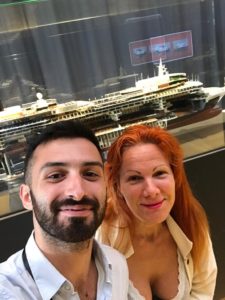


 Acquitania, the german liners with four funnels. That was very interesting! There were more ships than I couldn’t imagined, and they were so beautiful with their architectures and lavish interiors. And that was shortly after Maxtone Graham’s book “The Only Way to Cross” was published that is a beautifully written book and anybody, just the average person, would read that and think ocean liners were magnificent creations. So that, and also the movie: “The Poseidon Adventure”. All at the same time made me think ships were fantastic and need to know more, collect brochures and get any book -and there weren’t many books back then- . So I would have to go to the library and try to find prints and magazines, doing researches on the ships… Then I started visiting them in 1974, and that’s when I absolutely fell in love. My first ship was an old british liner: the Arcadia for P&O Lines. A 1954, beautiful wood work, linoleum decking, edge class panels. I was hooked, and that’s when I thought that I had to visit any ship coming to Los Angeles from that moment. I was too young to drive, so my mother or my father had to drive me down, and I would spend my day photographing the ships.
Acquitania, the german liners with four funnels. That was very interesting! There were more ships than I couldn’t imagined, and they were so beautiful with their architectures and lavish interiors. And that was shortly after Maxtone Graham’s book “The Only Way to Cross” was published that is a beautifully written book and anybody, just the average person, would read that and think ocean liners were magnificent creations. So that, and also the movie: “The Poseidon Adventure”. All at the same time made me think ships were fantastic and need to know more, collect brochures and get any book -and there weren’t many books back then- . So I would have to go to the library and try to find prints and magazines, doing researches on the ships… Then I started visiting them in 1974, and that’s when I absolutely fell in love. My first ship was an old british liner: the Arcadia for P&O Lines. A 1954, beautiful wood work, linoleum decking, edge class panels. I was hooked, and that’s when I thought that I had to visit any ship coming to Los Angeles from that moment. I was too young to drive, so my mother or my father had to drive me down, and I would spend my day photographing the ships.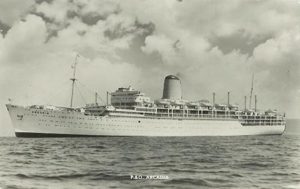
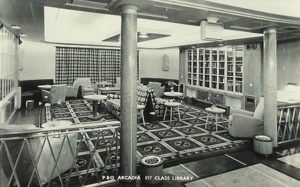
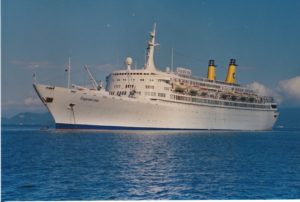 note) told me that here in Italy, when they were designing the Eugenio C, they were arguing for days and days about the curved superstructures of the ship. They had to make beauty before function. Beauty and function is the ultimate, but sometimes you give up a little function for that beauty, so that when people saw the Eugenio C sailing by, they would say that it was a magnificent ship and they would love to sail on her. Not a big giant floating carnival park full of distractions. These new ships are a all different thing. And people today, sadly, at least where I’m from, they don’t care so much if the ship looks beautiful. They want fifteen different specialty restaurants, they want the SPA, they want balconies, they want all these amenities and it makes sense! This is why they go on a cruise, they want these things. So today it is nice to look at those old ships in books but we rather have a big new ship.
note) told me that here in Italy, when they were designing the Eugenio C, they were arguing for days and days about the curved superstructures of the ship. They had to make beauty before function. Beauty and function is the ultimate, but sometimes you give up a little function for that beauty, so that when people saw the Eugenio C sailing by, they would say that it was a magnificent ship and they would love to sail on her. Not a big giant floating carnival park full of distractions. These new ships are a all different thing. And people today, sadly, at least where I’m from, they don’t care so much if the ship looks beautiful. They want fifteen different specialty restaurants, they want the SPA, they want balconies, they want all these amenities and it makes sense! This is why they go on a cruise, they want these things. So today it is nice to look at those old ships in books but we rather have a big new ship.

 preserved. You know, you could go in the cabins and still find Italian Line’s daily programs that were left over from the 70s because nobody touched the ship. She was just kept in immaculate conditions all those years. Then, they opened it as a hotel but she didn’t do so well because nobody wanted to travel to the Philippines. She just sat there and they used her for functions like Miss Universe contests and thing like that, but they didn’t make her an actual functioning hotel. So finally, when the owner was too old, he no longer wanted to keep her. She was like his toy, and that’s when my heart broke, when he sold her for scrap. I thought that of all the ocean liners in the world, she was the one. She needed to come back to Genova and to be right there, on Molo Vecchio (Mr.Knego points the Molo Vecchio while talking, editor’s note). But instead, they wanted the yacht harbour, the fancy yachts. So the plan didn’t happen and she went to Alang. I went to see all the other ships and they all broke my heart, but the Augustus, for me, was the biggest tragedy. To think that she was there, perfectly intact, but they would cut this beautiful sculpture of
preserved. You know, you could go in the cabins and still find Italian Line’s daily programs that were left over from the 70s because nobody touched the ship. She was just kept in immaculate conditions all those years. Then, they opened it as a hotel but she didn’t do so well because nobody wanted to travel to the Philippines. She just sat there and they used her for functions like Miss Universe contests and thing like that, but they didn’t make her an actual functioning hotel. So finally, when the owner was too old, he no longer wanted to keep her. She was like his toy, and that’s when my heart broke, when he sold her for scrap. I thought that of all the ocean liners in the world, she was the one. She needed to come back to Genova and to be right there, on Molo Vecchio (Mr.Knego points the Molo Vecchio while talking, editor’s note). But instead, they wanted the yacht harbour, the fancy yachts. So the plan didn’t happen and she went to Alang. I went to see all the other ships and they all broke my heart, but the Augustus, for me, was the biggest tragedy. To think that she was there, perfectly intact, but they would cut this beautiful sculpture of  a ship into pieces and melt her down. So I made sure that I rescued everything I could. I got furnitures, some of the light fixtures which are now in the Victoria & Albert Museum on display, I have a beautiful panel by Marangoni (Tranquillo Marangoni ndr.), a magnificent wooden panel called “The Green House” (“La serra” in italian, editor’s note). And for some reasons “Italia” didn’t remove it when they sold the ship! Crazy! So now it’s in my house and everyday I walk by pieces of Augustus. I have one of her in tables from the suites in my bedroom, under a panel by Luzzati from Eugenio C stair tower. Then I have another painting by Luzzati from Stella Maris of a circean calypso. He did all panels depicting greek mythology on the Sun Lines ships, just magnificent! And I come here and of course the Museo Luzzati it’s so nice to have, but they have nothing. Only just the drawings that he did in the very end of its life for children. They’re beautiful but nothing compared to what he did for the ocean liners. So I live in a world of Luzzati, Paolucci, Marangoni…
a ship into pieces and melt her down. So I made sure that I rescued everything I could. I got furnitures, some of the light fixtures which are now in the Victoria & Albert Museum on display, I have a beautiful panel by Marangoni (Tranquillo Marangoni ndr.), a magnificent wooden panel called “The Green House” (“La serra” in italian, editor’s note). And for some reasons “Italia” didn’t remove it when they sold the ship! Crazy! So now it’s in my house and everyday I walk by pieces of Augustus. I have one of her in tables from the suites in my bedroom, under a panel by Luzzati from Eugenio C stair tower. Then I have another painting by Luzzati from Stella Maris of a circean calypso. He did all panels depicting greek mythology on the Sun Lines ships, just magnificent! And I come here and of course the Museo Luzzati it’s so nice to have, but they have nothing. Only just the drawings that he did in the very end of its life for children. They’re beautiful but nothing compared to what he did for the ocean liners. So I live in a world of Luzzati, Paolucci, Marangoni…
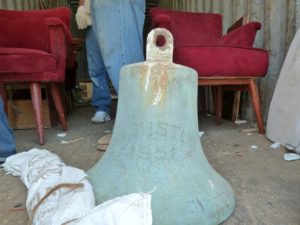
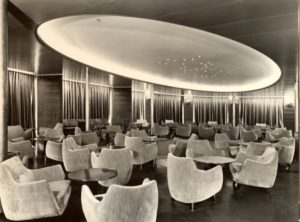 designed and Ponti signed off one of it and said: “Yes, I like that chair, go with it”. But if I say it’s a Zoncada they go: “That’s nice”. But if it’s mid-century italian they’re very interested, because in the States, right now, that’s very popular. But the ship history? No, not so much. If you say Augustus they answer that they don’t know the ship. Andrea Doria? Yes they know off course, but there’s nothing to save from the Andrea Doria that hasn’t been very damaged. With Augustus, there were some light fixtures by Artoluce in Trieste. Those lights are very very valuable as well. I didn’t know when I purchased them, I just thought they were beautiful and I would save them. I sold many of the things but now, with Augustus, everything that I have, I keep. Because when I’m gone in thirty years? Hopefully fourty, hopefully better? I want these things all to be kept together. I
designed and Ponti signed off one of it and said: “Yes, I like that chair, go with it”. But if I say it’s a Zoncada they go: “That’s nice”. But if it’s mid-century italian they’re very interested, because in the States, right now, that’s very popular. But the ship history? No, not so much. If you say Augustus they answer that they don’t know the ship. Andrea Doria? Yes they know off course, but there’s nothing to save from the Andrea Doria that hasn’t been very damaged. With Augustus, there were some light fixtures by Artoluce in Trieste. Those lights are very very valuable as well. I didn’t know when I purchased them, I just thought they were beautiful and I would save them. I sold many of the things but now, with Augustus, everything that I have, I keep. Because when I’m gone in thirty years? Hopefully fourty, hopefully better? I want these things all to be kept together. I  hope the world would be ready for it. I was very happy to see in Galata (Galata Museo del Mare, Genova, editor’s note) the Andrea Doria exhibit. And it was crowded! People were there, they were enjoying it! Maybe ocean liners will make a comeback in people’s minds and they will think: “Okay, what happened to all these ships? Isn’t it nice that some of them still survived?”. Let’s make a museum, just ocean liners, furnitures, art works, fittings. Show the pictures of their glory, show them at the scrapyard because it’s also a very fascinating procedure in India. To see Augustus on the beach, her entire hull out of water. This magnificent creation. Not in a drydock, not at a pier, but fully exposed on a natural beach was, to me, the most beautiful thing and at the same time very sad, because it was just for a very short period of time before they started demolishing her. But, to see the pictures, and I believe you had, to see her looking so magnificent, powerful…
hope the world would be ready for it. I was very happy to see in Galata (Galata Museo del Mare, Genova, editor’s note) the Andrea Doria exhibit. And it was crowded! People were there, they were enjoying it! Maybe ocean liners will make a comeback in people’s minds and they will think: “Okay, what happened to all these ships? Isn’t it nice that some of them still survived?”. Let’s make a museum, just ocean liners, furnitures, art works, fittings. Show the pictures of their glory, show them at the scrapyard because it’s also a very fascinating procedure in India. To see Augustus on the beach, her entire hull out of water. This magnificent creation. Not in a drydock, not at a pier, but fully exposed on a natural beach was, to me, the most beautiful thing and at the same time very sad, because it was just for a very short period of time before they started demolishing her. But, to see the pictures, and I believe you had, to see her looking so magnificent, powerful…
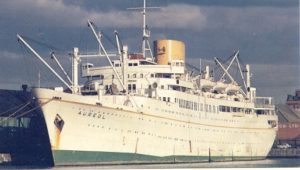 accomodation ship in the middle east. Never changed, never updated. So when she went for scrap, that’s when I thought that I had to start buying things. I was afraid to go to India, I didn’t have any contact, I didn’t know what it was like there. I am mad at myself because you know, they say that In life it’s not the things that you do that you regret, it’s the things you don’t do. And I wish I went for Aureol. She was also there with the Principe Perfeito, which was a portuguese liner –british built- also very beautiful. So I bought things from those ships and when they came to my home I said: “Next time an important ship goes, since I have made a contact in India that is going to help me, I’m going”. So there were nine or ten ships, all at once: the Empress of Canada, the Transvaal Castle, the Stella Solaris which was filled with Luzzati, Stella Oceanis also with Luzzati… And when all those ships were there I thought: “This is it, I’m going!”. And I wish I spent more time there. I booked two weeks, I took a week off and went to Delhi and the Taj Mahal, because everyone wants to see those things, but they will be there forever! And I wish I had that extra week in Alang because there were so many more things that I could have done, seen and documented. But that was the trip and then I decided after that, once I have made my friend
accomodation ship in the middle east. Never changed, never updated. So when she went for scrap, that’s when I thought that I had to start buying things. I was afraid to go to India, I didn’t have any contact, I didn’t know what it was like there. I am mad at myself because you know, they say that In life it’s not the things that you do that you regret, it’s the things you don’t do. And I wish I went for Aureol. She was also there with the Principe Perfeito, which was a portuguese liner –british built- also very beautiful. So I bought things from those ships and when they came to my home I said: “Next time an important ship goes, since I have made a contact in India that is going to help me, I’m going”. So there were nine or ten ships, all at once: the Empress of Canada, the Transvaal Castle, the Stella Solaris which was filled with Luzzati, Stella Oceanis also with Luzzati… And when all those ships were there I thought: “This is it, I’m going!”. And I wish I spent more time there. I booked two weeks, I took a week off and went to Delhi and the Taj Mahal, because everyone wants to see those things, but they will be there forever! And I wish I had that extra week in Alang because there were so many more things that I could have done, seen and documented. But that was the trip and then I decided after that, once I have made my friend 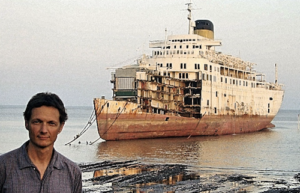 there, and he took good care of me and snuck me into the yards and he understood my passion and fell in love with the ships himself, that’s when I said: “Next time another important old liner goes to India, I’m going”. And that next ships was Eugenio C… And then Windor Castle. Both were there at the same time. So I made that second trip and so on. Everytime, expecially the italian liners. The Lloyd Triestino’s Victoria, which was Anastasis in her last. Again, another ship one hundred percent intact! Just as designed, because she was a christian missionary ship, so nobody updated her with, you know, new condominium type of staterooms. So she was also beautiful and I got many things from her as well. And then Ausonia…
there, and he took good care of me and snuck me into the yards and he understood my passion and fell in love with the ships himself, that’s when I said: “Next time another important old liner goes to India, I’m going”. And that next ships was Eugenio C… And then Windor Castle. Both were there at the same time. So I made that second trip and so on. Everytime, expecially the italian liners. The Lloyd Triestino’s Victoria, which was Anastasis in her last. Again, another ship one hundred percent intact! Just as designed, because she was a christian missionary ship, so nobody updated her with, you know, new condominium type of staterooms. So she was also beautiful and I got many things from her as well. And then Ausonia…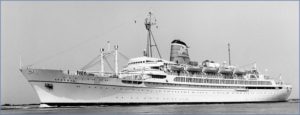
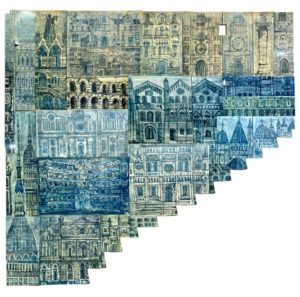 very rough, so they said that we had to spend the night onboard. She was abandoned and it was very sad and very… wet! But it was a magnificent experience because I had all the time I wanted to go wander to the officer’s quarter, and find the builders plan, logbooks and all of the things that I never would have been able to see because usually, when you go on a ship, they rush you and get you off. So that was lovely, I spent one last night on Ausonia in the suite that I sailed in on the ship when she was still sailing with Louis. Althought it was a little more dirty and sticky! But she was a lovely, lovely ship!
very rough, so they said that we had to spend the night onboard. She was abandoned and it was very sad and very… wet! But it was a magnificent experience because I had all the time I wanted to go wander to the officer’s quarter, and find the builders plan, logbooks and all of the things that I never would have been able to see because usually, when you go on a ship, they rush you and get you off. So that was lovely, I spent one last night on Ausonia in the suite that I sailed in on the ship when she was still sailing with Louis. Althought it was a little more dirty and sticky! But she was a lovely, lovely ship!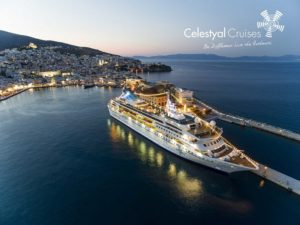 here and sail on an MSC: they are expecting a european experience. They like to travel with different people, different cultures, different languages, eat different food. Those are the types of americans that I like. Because they understand the world and didn’t think that the world revolves around America. And those people are much more fun to be with than the typical american passenger. So I would never come to Europe and sail on Disney, or NCL or Carnival. Not that they’re bad, they’re fine, they’re very good product. But I would much rather experience a european product when I’m travelling in Europe. Greek ships in Greece, italian ships in the Mediterranean.
here and sail on an MSC: they are expecting a european experience. They like to travel with different people, different cultures, different languages, eat different food. Those are the types of americans that I like. Because they understand the world and didn’t think that the world revolves around America. And those people are much more fun to be with than the typical american passenger. So I would never come to Europe and sail on Disney, or NCL or Carnival. Not that they’re bad, they’re fine, they’re very good product. But I would much rather experience a european product when I’m travelling in Europe. Greek ships in Greece, italian ships in the Mediterranean. very into the experience. When the people on the Carnival or NCL ships are going to Alaska, they’re going to Juneau and Ketchikan, and they’re going to giant shopping malls, and if they have a lot of money maybe they fly over a glacier. But they are not touching and feeling and experiencing the place that plus. So there’s a big difference. But there are ships, and there are americans, I should say, there’s a wide variety of americans fortunately. And there are certain ships: Oceania, Viking and Azamara. Those cruise lines cater to a more cultured type of passenger. They want to eat good food, they want to have good enrichment lectures and they want to go on excursions where they can actually learn and experience. So it’s not just about going to the rum bar and having an extra drink or two. Or doing a wet t-shirt contest… It’s an all different kind of passenger! So there are some lines that cater to the people who want culture, and lines who cater to the people want to party. There’s something for everybody in America.
very into the experience. When the people on the Carnival or NCL ships are going to Alaska, they’re going to Juneau and Ketchikan, and they’re going to giant shopping malls, and if they have a lot of money maybe they fly over a glacier. But they are not touching and feeling and experiencing the place that plus. So there’s a big difference. But there are ships, and there are americans, I should say, there’s a wide variety of americans fortunately. And there are certain ships: Oceania, Viking and Azamara. Those cruise lines cater to a more cultured type of passenger. They want to eat good food, they want to have good enrichment lectures and they want to go on excursions where they can actually learn and experience. So it’s not just about going to the rum bar and having an extra drink or two. Or doing a wet t-shirt contest… It’s an all different kind of passenger! So there are some lines that cater to the people who want culture, and lines who cater to the people want to party. There’s something for everybody in America.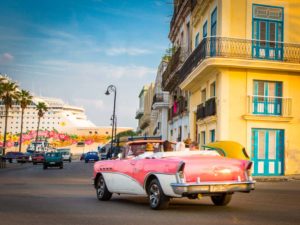 agencies and we consider that an old ship”. And I’m like: “Well, I’m getting very old than, because that’s not an old ship to me”. But that is the way people are thinking. You know, there is a race car riding on the new NCL ship and everybody’s coming up with some new “crazy but fun” thing. Like on the Seaview, she got a lot of things: she got a zip-line and an incredible waterpark. I think those other ships that are smaller ships but too big to me, they are ok for now because there are some markets in the US where they fit perfectly. Short cruises to the Bahamas -Carnival is using their old eight Fantasy Class ships to do those- or cruises to Mexico from Los Angeles. So, as long as there are small markets like that, the small to medium size ships have a home. Now Cuba has opened up, and you can’t get the big ships to Havana, and that’s the biggest port in Cuba. So some of the ships like the old Empress by Royal Caribbean has now come back into the fleet, and she’s popular because she’s perfect for that itinerary. So as long as there are certain itineraries like that, it’s good. I think those ships will be in big trouble if another bad incident happens. A highjacking , a terrorist thing or some disasters like the Concordia, those are the first ships to go. They will have troubles in being filled if the market get damaged, but the market it’s very healthy right now.
agencies and we consider that an old ship”. And I’m like: “Well, I’m getting very old than, because that’s not an old ship to me”. But that is the way people are thinking. You know, there is a race car riding on the new NCL ship and everybody’s coming up with some new “crazy but fun” thing. Like on the Seaview, she got a lot of things: she got a zip-line and an incredible waterpark. I think those other ships that are smaller ships but too big to me, they are ok for now because there are some markets in the US where they fit perfectly. Short cruises to the Bahamas -Carnival is using their old eight Fantasy Class ships to do those- or cruises to Mexico from Los Angeles. So, as long as there are small markets like that, the small to medium size ships have a home. Now Cuba has opened up, and you can’t get the big ships to Havana, and that’s the biggest port in Cuba. So some of the ships like the old Empress by Royal Caribbean has now come back into the fleet, and she’s popular because she’s perfect for that itinerary. So as long as there are certain itineraries like that, it’s good. I think those ships will be in big trouble if another bad incident happens. A highjacking , a terrorist thing or some disasters like the Concordia, those are the first ships to go. They will have troubles in being filled if the market get damaged, but the market it’s very healthy right now.